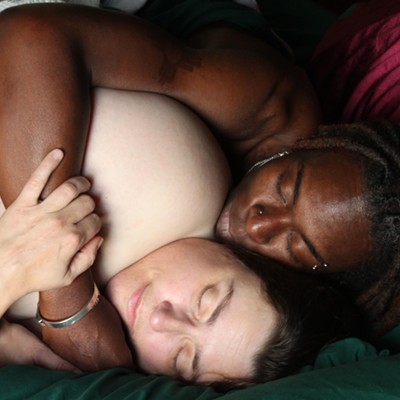During his career, Louis Kahn designed buildings ranging from an Ivy League art gallery to the capitol building of Bangladesh, structures of intense geometric rigor. But perhaps his most accomplished work was fashioning the façade of a normal existence from an unwieldy personal life ... a life that, as My Architect documents, included having three separate families near his Philadelphia home.
So it's fitting that Pittsburghers know him for a structure that plays multiple roles as well -- both as a boat and as a performance space, whose owner must be one of the world's few orchestra conductors with a pilot's license for 1,000-ton vessels.
The stage was the home for the American Wind Symphony Orchestra, a music ensemble consisting largely of wind instruments. (For those of you who dozed off during music appreciation, those include brass instruments such as the trumpet and woodwinds such as the clarinet.) The orchestra's founder was Robert Boudreau, a New England chicken farmer who -- presumably like many chicken farmers -- had big dreams of doing something else.
An accomplished trumpet player, Boudreau landed a teaching gig at Duquesne University's music program. There he hatched the idea for a wind symphony, something Boudreau says "never really existed before." String ensembles were popular, but a wind symphony was an unusual variation.
It was about to get more unusual still. In the mid-1950s, Boudreau sought to create a performance space for his fledgling group. He approached the Heinz Foundation for money, whereupon foundation head Jack Heinz asked, "Why don't you use the rivers?"
One reason, of course, was that Boudreau didn't have a boat. But with some encouragement, he took a trip out to the Dravo facility on Neville Island -- which in those days was the one-stop shopping location for anyone looking to put a small orchestra afloat. But even with the backing of Heinz, money was tight. When Dravo engineers asked Boudreau how much money he had, "I was making about $4,000 a year as a professor at Duquesne, so I said '$4,000.' It was the only figure I could think of. They said, 'We've got the boat for you,' and they took me to the back of the island. I said, 'Where is it?' And they said, 'Down there.' It was underwater."
But the vessel was dredged up, refurbished with a stage, and named Point/Counterpoint.
The vessel had no motor, so unless Boudreau was content ending up in the Gulf of Mexico, the stage had to be towed upstream. Later, Boudreau sought to replace it with the aptly named Point/Counterpoint II, a self-propelled barge he hoped would help his orchestra earn an international reputation. And he'd heard that the best architect working at the time was Philadelphia-based Louis Kahn.
If you're like me, you might think designing a combination river vessel and orchestra stage would be a snap. But then if you're like me, you don't know anything about boats or wind orchestras. Boudreau's vessel needed a 25-foot-high proscenium arch for sound to bounce off of, but it also needed to slip beneath bridges with clearances of as little as 10 feet. His musicians needed a stage 35 feet wide, but the boat had to navigate through locks of half that width.
But Kahn's personal life had prepared him for accommodating conflicting demands, and he designed a singular ship: The stage boasts an acoustic shell that rises up on hydraulic lifts. When the performance is over, the shell is lowered for travel.
To Boudreau, Kahn's design embodied everything that made him a great architect. But he recalls that Kahn's early proposals didn't hold water. "We went to the naval architects, and he presented his drawings to them. And they said, 'It's a very pretty design, but it's going to sink.' He took it all in stride."
In the end, the boat turned out to be a little more self-propelled than Boudreau intended. "I think it was 1995 -- I try to forget that year. The weather bureau said the river was going up three feet and instead it went up 30. I stayed on the boat that night, when the barges were plowing into it. The next morning I looked out and I was heading down I-279 on my boat. I don't have a license for that."
Lately, the boat hasn't traveled that much. Throughout the mid- to late-1990s, the boat was tied up. But beginning June 4, the Point/Counterpoint II will take to the water again. Starting in Brownsville, Pennsylvania -- once a center of Pittsburgh's boat-building industry -- the boat will travel the Mon and Ohio, visiting more than a dozen communities in West Virginia alone. Odds are they could even end up playing for a descendent of Louis Kahn.










